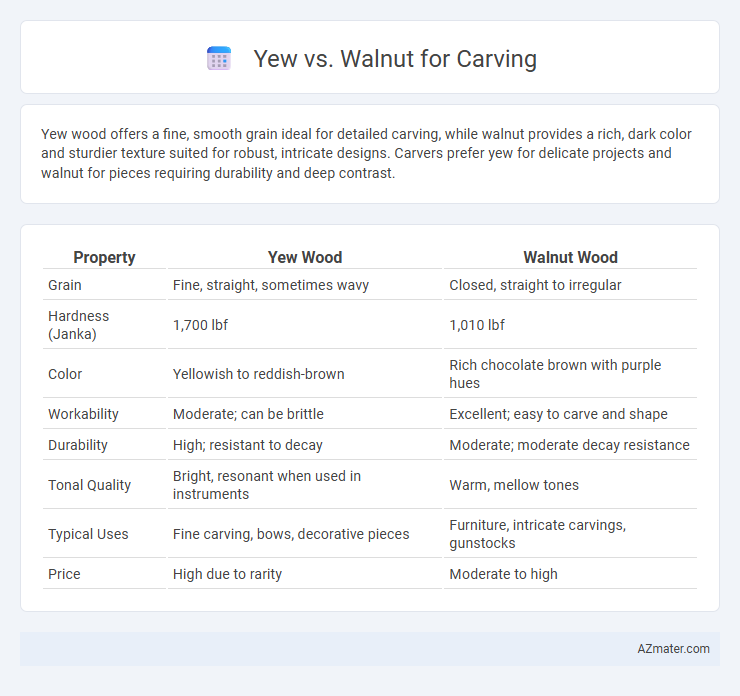Yew wood offers a fine, smooth grain ideal for detailed carving, while walnut provides a rich, dark color and sturdier texture suited for robust, intricate designs. Carvers prefer yew for delicate projects and walnut for pieces requiring durability and deep contrast.
Table of Comparison
| Property | Yew Wood | Walnut Wood |
|---|---|---|
| Grain | Fine, straight, sometimes wavy | Closed, straight to irregular |
| Hardness (Janka) | 1,700 lbf | 1,010 lbf |
| Color | Yellowish to reddish-brown | Rich chocolate brown with purple hues |
| Workability | Moderate; can be brittle | Excellent; easy to carve and shape |
| Durability | High; resistant to decay | Moderate; moderate decay resistance |
| Tonal Quality | Bright, resonant when used in instruments | Warm, mellow tones |
| Typical Uses | Fine carving, bows, decorative pieces | Furniture, intricate carvings, gunstocks |
| Price | High due to rarity | Moderate to high |
Yew vs Walnut: An Introduction to Carving Woods
Yew and walnut are popular carving woods valued for their distinct grain and workability, with yew offering a dense, fine texture ideal for detailed carvings and rich reddish hues that deepen over time. Walnut features a darker, chocolate-brown color with a smooth, consistent grain that carves easily and holds intricate detail, making it favored for both traditional and contemporary woodworking projects. Selecting between yew and walnut depends on desired aesthetic qualities and carving techniques, as yew balances hardness with elasticity, while walnut provides stability and a polished finish.
Wood Grain and Texture: Comparing Yew and Walnut
Yew wood features a fine, even grain with a smooth texture that allows for intricate, detailed carving, making it ideal for delicate and precise designs. Walnut has a straight grain with occasional waves or curls, providing a slightly coarser texture that holds fine detail well but offers more natural variation in appearance. Both woods are valued in carving, with Yew favored for its consistency and Walnut prized for its rich, dynamic grain patterns.
Workability: Ease of Carving Yew vs Walnut
Yew wood is highly valued for its fine grain and moderate hardness, making it easier to carve intricate details with precision compared to walnut. Walnut's denser and tighter grain offers durability but requires sharper tools and more effort, which may slow the carving process. Carvers often prefer yew for projects needing delicate, detailed work due to its smoother cutting experience and minimal grain interference.
Durability and Longevity in Carvings
Yew wood offers moderate durability with a fine grain that allows for intricate detailing but may wear down faster over time compared to Walnut. Walnut is renowned for its exceptional strength and resistance to decay, making carvings highly durable and long-lasting. Choosing Walnut enhances the longevity of detailed sculptures due to its stability and natural oils that protect against environmental damage.
Aesthetic Appeal: Color and Finish Differences
Yew wood features a warm, golden-yellow hue with rich red streaks, providing a natural luster that enhances detailed carvings and develops a smooth, satin finish over time. Walnut offers a deep chocolate brown color with purplish undertones that darken with age, creating a luxurious contrast that highlights intricate patterns and fine details. Both woods accept finishes well, but Yew's lighter tones emphasize grain patterns, while Walnut's darker shades provide a dramatic, elegant backdrop for carving projects.
Availability and Cost Considerations
Yew is more widely available in Europe and tends to be moderately priced due to its relative abundance, making it a cost-effective option for carvers seeking fine detail work. Walnut, particularly black walnut, is commonly found in North America and generally commands a higher price because of its rich color and durability, which appeals to premium woodworking projects. Availability fluctuates regionally for both woods, so local supply and demand significantly influence their cost and accessibility for carving purposes.
Toxicity and Safety: Yew vs Walnut for Woodworkers
Yew wood contains toxic compounds called taxines, which can pose health risks to woodworkers through inhalation of sawdust or skin contact, requiring protective gear like masks and gloves. Walnut is generally considered safer, although its dust may still cause allergic reactions or irritation, making dust extraction and ventilation important during carving. Prioritizing safety protocols and adequate protective equipment minimizes exposure risks when working with both Yew and Walnut woods.
Best Uses: Ideal Projects for Yew and Walnut
Yew wood, with its fine grain and elasticity, is best suited for intricate carvings, fine details, and small decorative items such as jewelry boxes or walking sticks, where precision and smooth finishes are essential. Walnut, known for its rich color and durability, excels in larger projects like furniture, sculptures, and musical instruments, benefiting from its strength and ability to hold sharp details over time. Both woods offer unique aesthetic and functional properties that cater to different carving needs and project scales.
Tool Selection and Maintenance for Each Wood
Yew wood's dense, fine grain requires sharp, high-quality tools such as carbon steel or carbide-tipped chisels to achieve precise cuts and detailed carving. Walnut, being moderately hard with an open grain, responds well to high-speed steel tools sharpened frequently to maintain a clean edge and prevent tear-out. Regular honing and oiling of tools after working with oily walnut and resinous yew preserve blade sharpness and extend tool life, ensuring optimal carving performance for each wood type.
Conclusion: Choosing the Right Wood for Your Next Carving Project
Yew offers a fine, dense grain and is prized for detailed, intricate carving projects due to its smooth finish and workability. Walnut provides a rich, deeper color with moderate hardness, making it ideal for larger, more robust carvings that require durability and a striking appearance. Choosing between yew and walnut depends on the desired carving detail, project size, and aesthetic preference, with yew suited for delicate craftsmanship and walnut favored for strength and visual impact.

Infographic: Yew vs Walnut for Carving
 azmater.com
azmater.com